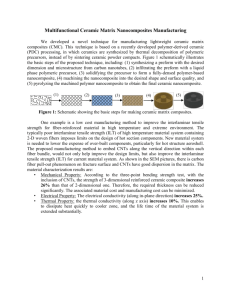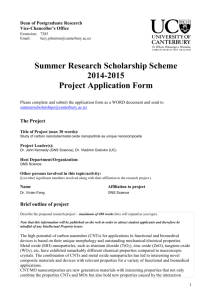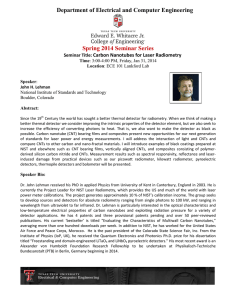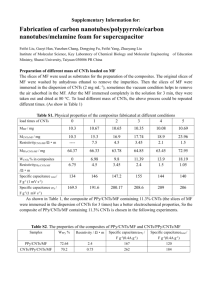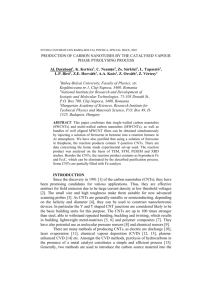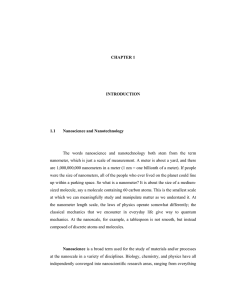Document 14671137
advertisement
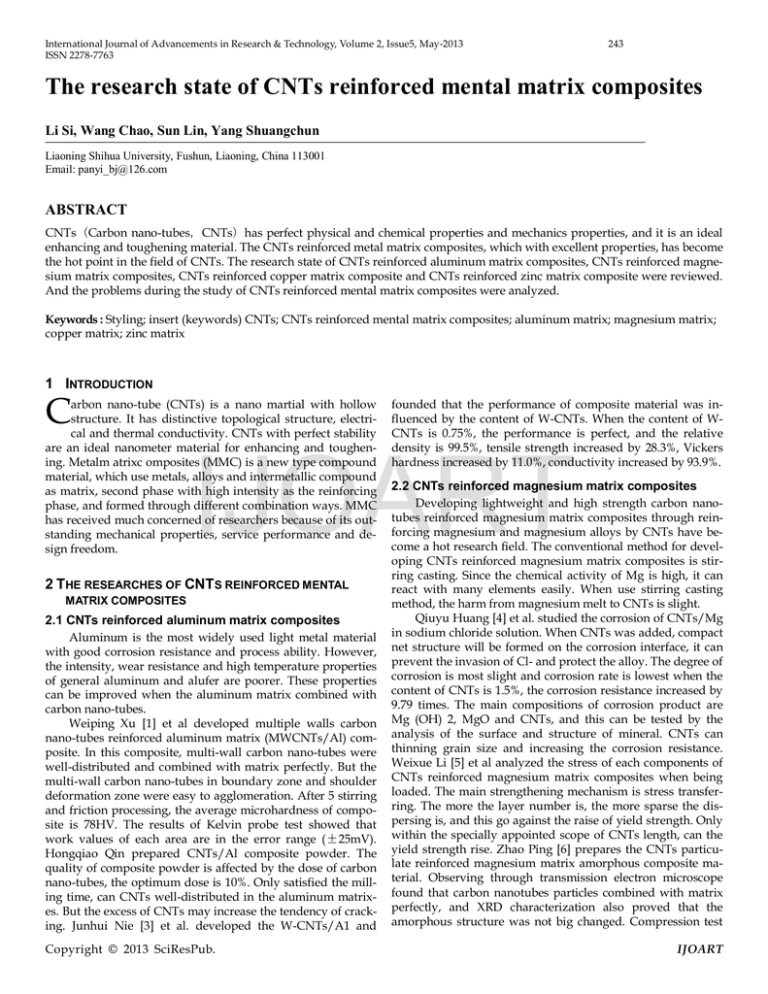
International Journal of Advancements in Research & Technology, Volume 2, Issue5, May-2013 ISSN 2278-7763 243 The research state of CNTs reinforced mental matrix composites Li Si, Wang Chao, Sun Lin, Yang Shuangchun Liaoning Shihua University, Fushun, Liaoning, China 113001 Email: panyi_bj@126.com ABSTRACT CNTs(Carbon nano-tubes,CNTs)has perfect physical and chemical properties and mechanics properties, and it is an ideal enhancing and toughening material. The CNTs reinforced metal matrix composites, which with excellent properties, has become the hot point in the field of CNTs. The research state of CNTs reinforced aluminum matrix composites, CNTs reinforced magnesium matrix composites, CNTs reinforced copper matrix composite and CNTs reinforced zinc matrix composite were reviewed. And the problems during the study of CNTs reinforced mental matrix composites were analyzed. Keywords : Styling; insert (keywords) CNTs; CNTs reinforced mental matrix composites; aluminum matrix; magnesium matrix; copper matrix; zinc matrix 1 INTRODUCTION C arbon nano-tube (CNTs) is a nano martial with hollow structure. It has distinctive topological structure, electrical and thermal conductivity. CNTs with perfect stability are an ideal nanometer material for enhancing and toughening. Metalm atrixc omposites (MMC) is a new type compound material, which use metals, alloys and intermetallic compound as matrix, second phase with high intensity as the reinforcing phase, and formed through different combination ways. MMC has received much concerned of researchers because of its outstanding mechanical properties, service performance and design freedom. founded that the performance of composite material was influenced by the content of W-CNTs. When the content of WCNTs is 0.75%, the performance is perfect, and the relative density is 99.5%, tensile strength increased by 28.3%, Vickers hardness increased by 11.0%, conductivity increased by 93.9%. IJOART 2 THE RESEARCHES OF CNTS REINFORCED MENTAL MATRIX COMPOSITES 2.1 CNTs reinforced aluminum matrix composites Aluminum is the most widely used light metal material with good corrosion resistance and process ability. However, the intensity, wear resistance and high temperature properties of general aluminum and alufer are poorer. These properties can be improved when the aluminum matrix combined with carbon nano-tubes. Weiping Xu [1] et al developed multiple walls carbon nano-tubes reinforced aluminum matrix (MWCNTs/Al) composite. In this composite, multi-wall carbon nano-tubes were well-distributed and combined with matrix perfectly. But the multi-wall carbon nano-tubes in boundary zone and shoulder deformation zone were easy to agglomeration. After 5 stirring and friction processing, the average microhardness of composite is 78HV. The results of Kelvin probe test showed that work values of each area are in the error range (±25mV). Hongqiao Qin prepared CNTs/Al composite powder. The quality of composite powder is affected by the dose of carbon nano-tubes, the optimum dose is 10%. Only satisfied the milling time, can CNTs well-distributed in the aluminum matrixes. But the excess of CNTs may increase the tendency of cracking. Junhui Nie [3] et al. developed the W-CNTs/A1 and Copyright © 2013 SciResPub. 2.2 CNTs reinforced magnesium matrix composites Developing lightweight and high strength carbon nanotubes reinforced magnesium matrix composites through reinforcing magnesium and magnesium alloys by CNTs have become a hot research field. The conventional method for developing CNTs reinforced magnesium matrix composites is stirring casting. Since the chemical activity of Mg is high, it can react with many elements easily. When use stirring casting method, the harm from magnesium melt to CNTs is slight. Qiuyu Huang [4] et al. studied the corrosion of CNTs/Mg in sodium chloride solution. When CNTs was added, compact net structure will be formed on the corrosion interface, it can prevent the invasion of Cl- and protect the alloy. The degree of corrosion is most slight and corrosion rate is lowest when the content of CNTs is 1.5%, the corrosion resistance increased by 9.79 times. The main compositions of corrosion product are Mg (OH) 2, MgO and CNTs, and this can be tested by the analysis of the surface and structure of mineral. CNTs can thinning grain size and increasing the corrosion resistance. Weixue Li [5] et al analyzed the stress of each components of CNTs reinforced magnesium matrix composites when being loaded. The main strengthening mechanism is stress transferring. The more the layer number is, the more sparse the dispersing is, and this go against the raise of yield strength. Only within the specially appointed scope of CNTs length, can the yield strength rise. Zhao Ping [6] prepares the CNTs particulate reinforced magnesium matrix amorphous composite material. Observing through transmission electron microscope found that carbon nanotubes particles combined with matrix perfectly, and XRD characterization also proved that the amorphous structure was not big changed. Compression test IJOART International Journal of Advancements in Research & Technology, Volume 2, Issue5, May-2013 ISSN 2278-7763 prove that the maximum compression strength and the fracture displacement were improved. The large area agglomeration of CNTs was not found. CNTs formed a lot of toughening nest structure in the matrix. But the change of macro plastic toughness material is not obvious. Zhou guohua [7] et al. prepared CNTs reinforced AZ31 magnesium matrix composites, and the effect of carbon nanotubes on corrosion resistant properties of magnesium alloys was tested. Doing the static salt water immersion test in 3.5% NaCl solution (mass fraction, the same below). Tests showed that the corrosion resistance improved obviously after adding CNTs. When the addition amount is 1.5% (mass fraction), the average corrosion rate dropped to 1.1069 mg/(m2·s). 2.3 CNTs reinforced copper matrix composite materials As the widely needs of high strength and high conductivity copper base materials in the lead frame and point electrodes and heat transfer coil in the fusion device, the study of copper matrix composites was promoted. CNTs have excellent mechanical and electrical conductivity, it can disperse in copper matrix and strengthened copper. And can prepare CNTs reinforced copper matrix composite materials with high temperature strength, good conductivity and thermal conductivity. Yinghui Zhang [8] et al prepare W-20% C/Cu composite materials using CNTs as the strengthening phase. The content of CNT can affect the density and hardness of the composite materials. CNTs can play a role of fine-grain strengthening when it added into 20% W-Cu composite materials. The density and hardness of the material increased with the increase of addition amount of CNTs. Junhui Nie [9] prepares CNTs/Cu composite material, and it has good interface bonding properties. CNTs can improve the tensile strength of the material. Through the observation and study of materials, when the mass fraction of CNTs is 1%, it is combined with copper substrate interface good, stress transfer is also good, and tensile strength increased by 59.6%, electrical conductivity increased by 75%. Fei Meng [10] et al using powder metallurgy technology with rolling annealing prepared CNTs dispersion strengthened copper matrix composites materials.The research showed that rolling technology can greatly improve the material density, the density is 78.7%before rolling, and the density reached 98.9% after rolling. The result also showed that there are large amounts of pore in materials, and rolling promoted the densification. At the same time, rolling technology also has a great effect on the hardness of material, and the brinell hardness increased from 49.2 to 96.4, the main reason is the density of the material increased, what’s more, CNTs dispersion strengthened also make the material hardness improve. Because the squeeze and the shear of adjacent copper particles during the process of rolling extrusion, the agglomerated CNTs distributed into the particle clearance, the greater the rolling passes, the more force clusters CNTs, the tensile deformation more fully, and its distribution is more uniform. 244 cient and poor dimensional stability of zinc alloy. Tang Qihua [11] et al. using powder metallurgy method prepared the CNTs reinforced zinc alloy composites materials, and the reasons of the wear-resistant of CNTs reinforced zinc-base composite were analyzed. The research showed that the friction coefficient of composites will decrease when the load content increasing. Under the steady-state friction conditions, friction coefficient matrix alloy is about 0121, the friction coefficient of the composite material is about 0114, and the adding of CNTs reduced the coefficient of friction materials. 3 THE PROBLEMS EXISTING 3.1 The well-distributed of CNTs in the matrix The key step during the preparation of CNTs reinforced metal matrix composites is the well-distributed of CNTs in the matrixes. But it is easy to agglomerate since the high specific area and specific surface area of CNTs. When the agglomeration happens in the grain boundaries, the grain boundary strength will decrease greatly. The frequently used method to solve this problem is ultrasonic dispersion and mechanical milling of CNTs in the liquid phase, but the agglomeration will happen inevitably during the subsequent processing. Furthermore, acid calcination and strong oxidation methods can add –OH and –COOH and other active groups on the sides and open ends of CNTs, and improve the dispersing of CNTs, but this also can’t receive the theoretical calculated value. IJOART 2.4 CNTs reinforced zinc matrix composite Zinc-base composite material is a kind of metal matrix composites developed in recent years. It has excellent mechanical properties and wear resistance, and can overcome the poor temperature resistant, large thermal expansion coeffiCopyright © 2013 SciResPub. 3.2 The compatibility of CNTs and matrix Since the slight surface of CNTs, the wettability of the boundaries between wild phase and metal matrix is poor. Now, a majority of researches are adding CNTs without surface treatment to metal matrix directly, and the combine of CNTs and matrix is slight. To solve this trouble, surface treatment can be adopted. The usually method is coating metal matrix on the surface of CNTs. Coating Cu、Ni、Ag、Co、 Mg on the surface of CNTs have been reported. After surface treatment, the boundaries of CNTs and matrix become stronger and the dispersing of CNTs was promoted. Therefore, the surface treatment of CNTs during the development of CNTs reinforced metal matrix composite is necessary. 3.3 The orientation of CNTs in metal matrix Now, the study of microcosmic structure of CNTs/metal composite only considering the relation between the content of CNTs and the performance of composite, rather than the mutual cooperation of CNTs and metal matrix, and neglecting the influence from the structures of CNTs and metal matrix. CNTs has the draw ratio which much bigger than whisker, but the size of caliber is much smaller than fiber. So the reinforce mechanism of CNTs is different from whisker and fiber. The possible reinforce mechanisms of CNTs are dispersion strengthening and bridging strengthening, but the related reinforce models haven’t set up. 4. CONCLUSION CNTs is a favorable reinforce material because of its special physical and chemical properties and mechanics properties. IJOART International Journal of Advancements in Research & Technology, Volume 2, Issue5, May-2013 ISSN 2278-7763 245 Though the study of CNTs reinforced metal materials has received some progress, it is still far from the practical application. The further research should around the following steps: developing efficient technology for the purification of CNTs and making it well-dispersing in the metal matrix; Surface treating the CNTs and heightening the wettability between CNTs and matrix; analyzing the reinforce mechanisms and building the reinforce models. REFERENCES [1] Xu Weiping, Xi Lihuan, Xing Li, et al. Studies on Uniformity of MWCNTs/Al Composites by Friction Stir Processing [J]. Journal of Nanchang Hangkong University (Natural Sciences). 2011, 25(4): 19-23. [2] Qin Hongqiao. Preparation of CNTs/Al composite power by mechanical ball milling [J]. Light Metals. 2011, (5): 59-61. [3] Nie Junhui, Shi Na, Zhang Yafeng, et al. Mechanical properties and electrical conductivity of tungsten-coated carbon nanotube reinforced aluminum matrix composites [J]. Powder Metallurgy Technology. 2011, 29(5): 344-350. [4] Huang Qiuyu, Zeng Xiaoshu, Wu Jicai, et al. Corrosion Behavior of Carbon Nano-tube/Mg-Zn Composite in Sodium Chloride Solution [J]. Hot Working Technology. 2011, (6):100-106. [5] Li Weixue, Zhu Jie, Dai Jianfeng, et al. An Analytical Solution for Strengthening Mechanisms of Carbon Nanotube Reinforced Magnesium Matrix Composites [J]. Materials Review. 2012, 26(2): 131-135. [6] ]Zhao Ping, Li Shuangshou, Peng Hao, et al. Preparation of Carbon-nanotube Reinforced Mg Based Bulk Metallic Glass Composites and Its Mechanical Properties [J]. Special Casting & Nonferrous Alloys. 2011, 31(7): 656-660. [7] Zhou Guohua, Zeng Xiaoshu, Zhang Zhan, et al. Effects of Carbon Nanotubes on the Corrosion Resistance of AZ31 Magnesium Alloy and Its Mechanism [J]. Rare Metal Materials and Engineering. 2011, 40(1): 101-105. [8] ]Zhang Yinghui, Tian Haixia, Zhu Gensong, et al. The density and hardness of W-Cu composite materials affected by nanotubes [J]. Nonferrous Metals Science and Engineering. 2012, 3(3): 33-35. [9] Nie Junhui, Jia Chengchang, Zhang Yafeng, et al. Fabrication of carbon nanotubes/ copper composites using mechanical milling and spark plasma sintering [J]. Powder Metallurgy Industry. 2011, 21(5):44-50. [10] Meng Fei, Pei Yanbin, Guo Shiju. Effects of rolling on microstructure of carbon nanotube dispersion strengthened copper alloys [J]. Materials Science and Engineering of Powder Metallargy. 2005, 10(1): 55-57. [11] Tang Qihua, Zhou Xiaohua. Study on the Wearable Performance of Carbon Nanotube/Zinc Alloy Marix Composites[J]. Journal Os Southern Institute of Metallurgy. 2004, 25(5): 14-16. IJOART Copyright © 2013 SciResPub. IJOART

